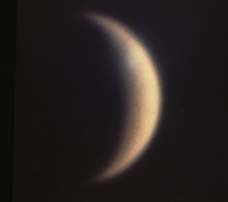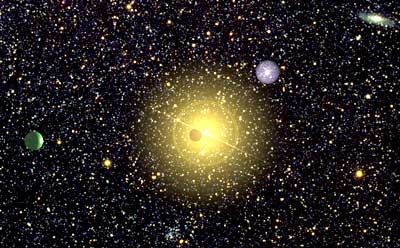|
Venus
- Overall: At 0.7 AU (the bright Morning or Evening Star, associated with the goddess of love
and beauty, Venus, Aphrodite, or Ishtar. It can transit the Sun! In closer views, the Blue Planet,
smooth and featureless from total cloud cover).
- Planet: Size 95% of Earth's, at 0.7 AU
from the Sun [225-day orbit]; Slow, retrograde rotation [with
243-day period], probably due to a past collision; No moons. US flybys in the 1960s; Soviet spacecraft have landed; Several orbiters, including currently Venus Express.
- Surface: Radio maps show mountains, rolling plains, riverbeds, coronas, some large craters and cracks from temperature changes; But the surface is young, less rugged than Earth's; Venus may have been totally resurfaced 500-700 Myr ago, like a pressure cooker.
- Atmosphere: Thick, high pressure (90 atm!), made of CO2,
N, with sulfuric acid clouds; 450°C (850°F) hot everywhere and always, because it traps heat very effectively; Dry, of dusty rocks, with no water (but it may have had water in the past); Only a dim orange light goes through; There is little erosion (not much rain or wind).
|


|


![]()